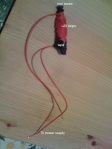At the LHC, the main experiment at CERN, protons and other charged particles generated during collisions are deflected using powerful electromagnets. These magnets can yield enormous B fields of several Tesla. For comparison, Earth’s magnetic field has a strenght of ~10^-4 T, a “natural” unit which is called Gauss after the guy who measured it first in 1835. How do these magnets work exactly? In their simplest form, they are solenoids. A solenoid is a loop of wire which produces a magnetic field when an electric current is passed through it. The magnetic field generated by such a device can be calculated beforehand by this master formula:
B = μ * n * I,
where:
- μ is the magnetic permeability of the medium
- n is the number of coils per meter
- I is the intensity of electric current measured in Ampere.
In the void, μ = 4*3.14*10^-7 = μ_0 which is an extremely small number! While air, plastic and wood have very low μ, metals usually provide a higher value. You can write this property as relative permeability w.r.t. void μ_R = μ / μ_0 or simply μ = μ_R * m_0 (easier for straightforward calculations IMHO). Just to give you some examples of μ:
- Mu-metal: 2.5 * 10^-2 (you won’t find this at home, 75% nickel, 15% iron, plus copper and molybdenum)
- Ferrite (nickel-zinc): 8 * 10^-4
- Steel: 8.75 * 10^-4
- Nickel: 1.25 * 10^-4
- Aluminium, Copper, water: 1.25 * 10^-6
- Superconductors: 0 (due to Meissner effect)
As for I, the current you can afford to use in a “homework” setting is typically in the order of few mA. A 9V battery can tipically supply 0.5Ah (i.e. 0.5 A integrated in one hour, at most – used this way it will probably melt your circuit). The number of coils per meter depends usually on the thickness of the wire and the number of layers. We will discuss it later on. All in all, what you should get from this considerations is that the B field you can create is usually quite weak. In fact, in order to produce an enormous field the LHC makes use of superconducting magnets, whose wires have a almost naught resistance thanks to this peculiar phenomenon called superconductivity. You can drive a current of several kA (!!!) in a superconducting wire! Unfortunately, at present it is practically impossible to do this at home. However, we can learn how to make a “normal” electromagnet using some stuff you can easily buy at your preferred electric shop.
- Copper wire (or better enameled copper wire)
- Some kind of metallic core for your solenoid (a screw in our example)
- Tape
- An AC/DC transformer, possibly with variable outgoing tension 1.5 – 12V, OR a series of alkaline AA (1.5V ~2000 mAh) batteries
- A compass or a glass of water + a needle
- Optional: a LED
So, let’s get it started. First of all, you have to build up your solenoid. Armed with patience, make the first round of coils. When you arrive at the end of the metallic core, put some tape to block its end, go the beginning again and start over. Iterate this several times (at least 4). Now you can attach your solenoid to the power supply you chose. Optionally, you can put a LED in series to check if the current is flowing.
In my case, the B field I can generated is (give or take):
I = V/R = 1.2V / ~10Ohm = 0.12A
B = μ * n * I = 1.25 * 10^-4 * ( 4 layers * 10 loops / 10 cm ) * 0.006A = 6 mT
For comparison, this is the strenght of a typical fridge magnet. According to Ohm’s first law, you
should try to keep the resistance of the circuit as low as possible, avoiding a short-circuit. This is why a LED is quite useful in this place! If you can tune you transformer output voltage, set it at minimum.
There are several ways to see the effect of your electromagnet. For instance, you
can take it close to a compass – you’ll see the needle following your magnet. Or, you could attract some iron dust. I tried with a metallic non-magnetized needle, but unfortunately my B field wasn’t strong enough to lift it. I chose to test it in a fancy way: I put some water in a candle support, and I placed a needle floating on its surface – surface tension will keep it from sinking. Then, just act as you would with a compass. It works!


Thanks for sharing superb informations. Your site is very cool. I’m impressed by the details that you’ve on this site. It reveals how nicely you perceive this subject. Bookmarked this website page, will come back for more articles. You, my friend, ROCK! I found just the info I already searched everywhere and just could not come across. What a perfect site. Take a look at my blog whenever you feel like doing so. thanks.!